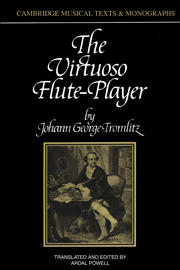Book contents
- Frontmatter
- Contents
- Translator's note
- Introduction by Eileen Hadidian
- Title in the series
- DETAILED AND THOROUGH TUTOR FOR PLAYING THE FLUTE
- Foreword
- Introduction
- 1 The flute and its character
- 2 Holding the flute, and the embouchure
- 3 Fingering
- 4 The notes and rests, their values and denominations, and the other musical signs
- 5 Time-signatures, and how the notes are divided and counted in them; the beat itself, or counting time according to an appointed tempo
- 6 Tone and pure intonation
- 7 Modern key-signatures
- 8 The articulation proper to this instrument, or the means of governing the wind suitably, as well in slow as in moderately quick movements; also called the single tongue
- 9 The technique for executing fast and very fast passages clearly and roundly; also, though improperly, called the ‘double tongue’
- 10 The ornaments
- 11 The trill
- 12 Fermatas and cadenzas
- 13 The taking of breath in flute-playing
- 14 The discretionary ornaments; or how to vary a simple melody according to the rules of harmony, and to use these variations in a good and suitable way appropriate to the material
- 15 Summary of the whole, together with a few remarks for pupils and masters
- Fingering-chart
- Select bibliography
- Index
Introduction by Eileen Hadidian
Published online by Cambridge University Press: 01 June 2011
- Frontmatter
- Contents
- Translator's note
- Introduction by Eileen Hadidian
- Title in the series
- DETAILED AND THOROUGH TUTOR FOR PLAYING THE FLUTE
- Foreword
- Introduction
- 1 The flute and its character
- 2 Holding the flute, and the embouchure
- 3 Fingering
- 4 The notes and rests, their values and denominations, and the other musical signs
- 5 Time-signatures, and how the notes are divided and counted in them; the beat itself, or counting time according to an appointed tempo
- 6 Tone and pure intonation
- 7 Modern key-signatures
- 8 The articulation proper to this instrument, or the means of governing the wind suitably, as well in slow as in moderately quick movements; also called the single tongue
- 9 The technique for executing fast and very fast passages clearly and roundly; also, though improperly, called the ‘double tongue’
- 10 The ornaments
- 11 The trill
- 12 Fermatas and cadenzas
- 13 The taking of breath in flute-playing
- 14 The discretionary ornaments; or how to vary a simple melody according to the rules of harmony, and to use these variations in a good and suitable way appropriate to the material
- 15 Summary of the whole, together with a few remarks for pupils and masters
- Fingering-chart
- Select bibliography
- Index
Summary
Johann George Tromlitz's Ausführlicher und gründlicher Unterricht die Flöte zu spielen, published in Leipzig in 1791, is a work of both theoretical and practical importance whose value is just becoming recognised by scholars and performers exploring musical practices of the late eighteenth century.
Until recently, relatively little study had been done on the flute and fluteplaying between the publication in 1752 of Johann Joachim Quantz's Versuch einer Anweisung die Flöte traversiere zu spielen and the first appearance of the fully chromatic flute designed by Theobald Boehm (c. 1832). Many of the tutors that appeared between 1760 and c. 1790 consisted mainly of elementary principles of flute-playing, or were paraphrases of Quantz and other earlier works. Our understanding and knowledge of late eighteenth-century performance practice is increased in Tromlitz's Unterricht, whose contents include much valuable information on flute-playing in the second half of the eighteenth century and on musical practice in general. Its fifteen comprehensive chapters explore topics ranging from elementary principles of flute-playing and particular advice on flute maintenance to thorough discussions of articulation, phrasing, breathing, ornamentation, improvised cadenzas and discretionary ornaments.
Tromlitz takes as his model Quantz's Versuch and elaborates on it. Tromlitz's indebtedness to the earlier authority is evident in the organisation and contents of the Unterricht. He limits his material to that found in Quantz's first sixteen chapters, those pertaining specifically to the flute, and does not address musical matters of a broader nature, such as the role of accompanying instruments, or musical forms and styles.
- Type
- Chapter
- Information
- The Virtuoso Flute-Player , pp. xiii - xxviPublisher: Cambridge University PressPrint publication year: 1991



